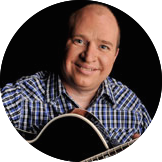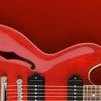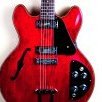-
Posts
134 -
Joined
-
Last visited
-
Days Won
8
Content Type
Profiles
Forums
Gallery
Events
Articles
Blogs
Downloads
Community Map
Posts posted by Wim VD
-
-
4 hours ago, Eracer_Team-DougH said:
For chords I don' know. I go here
That is an interesting site, Dough. I'm just starting with modes and this info is very useful. Thanks.
-
34 minutes ago, Cindy said:
The explanation end of it to help you understand why you will encounter these types of chords is it's an Ab major chord in first inversion. An Ab chord is made up of the notes AbCEb. Initially the chords we learn such as C, G, D, A, etc have the root of the chord as the lowest sounding note.
When a chord is in its first inversion, it means the 3rd of the chord (the C in your example) is now the lowest sounding note. So it is written as Ab/C
An Ab chord in second inversion would be written as Ab/Eb meaning the Eb is the lowest sounding note.
And if we are dealing with an Ab7 chord, there are a few times when you might see the chord in its third inversion which would have the 7th as the lowest sounding note...ie Ab/Gb. It's very weak to use the 7th as the lowest sounding note, but you might still encounter chords in their third inversion once in a while.
The reason why we use chords in first, second, and third inversions is to create a smooth sounding bass line in the music. If we didn't, when jumping around between chords such as C-G-C, the bass can sound choppy. If we use the G chord in its first inversion, the bass line would sound as C-B-C (written as C G/B C).
Cindy, thanks for the clear explanation on the inversions. That part was new to me.
Every day is a learning day :-)
Wim.
-
 1
1
-
-
Ron,
I just ordered it from Amazon and will give it a try in the coming weeks.
Gerard,
This evening I have been practicing with my looper playing the C Major Scale over a G7 Chord and listening what notes sounded well. Mixolydian mode played over a dominant 7th cord is a cool concept!
-
7 hours ago, matonanjin said:
Wim, I am about the same spot as you, " making my first small steps in soloing". I need to study Gerard's link a little more to try and figure this difference between chord tone and scale tone.
I have this book, Chord Tone Soloing. A Guitarist's Guide to Melodic Improvising in Any Style. It's a Hal Leonard book written by Barret Tagliarino. I also have a couple TrueFire courses on the subject.
Ron, thanks for the book suggestion. I had it on my list already based on some post on the old forum.
Did you work on these book materials and do they fulfill your expectations?
Wim.
5 hours ago, V7#5b9 said:@Wim VD The reason the chord tone approach sounds better to you is because you are using the harmonic framework of the progression. Chord tones are the safe, sweet notes the chords or arpeggios are made of. They are the notes you can hold or land on. When it comes to the seventh chords, the third and the seventh are the guide tones and you should target one of them when making the chord changes. Of course, the chord tones alone don’t make a great solo, but if you start with them, you will get the harmony into your ear and you will hear the chord changes. Then, you can start adding approach notes and here the devil is in the details that are way beyond the scope of a simple post.
So you decided to focus on learning the arpeggios starting with the dominant 7th chords. That’s a good idea because all you need for a traditional 12 bar blues is this one type of chord. The harmonic simplicity and structural economy of the 12 bar blues makes it the perfect vehicle for tackling soloing and improvisation in the early stages. So again, you start with chord tones only, then you add approach notes thereby building your solo from the bottom up. You can learn the arpeggios in isolation or from the perspective of its parent scale. The mixolydian which can be thought of as a major scale with a lowered seventh is the parent scale for a dominant 7th chord.
After you’ve completed Session 19, you may want to reach for a resource that thoroughly deals with soloing and improvisation in your chosen genre.
Gerard,
Thanks for your response. I will follow your advice and study the parent scales as well.
Reading through you posts I have often been wondering where you have gathered all your musical knowledge. Thanks again for willing to share this and helping me and others.
Wim.
-
I am currently making my first small steps in soloing, so this topic is very relevant to me. I have been trying out playing scales and playing chord tones over chord progressions, and the chord tone approach sounds beter to my ear. So I decided to focus on learning chord arpeggios in the months to come, starting with the dominant 7th chords, and then the major and minor 7th and eventually the m7b5.
Any advice is welcome on this topic. When it comes to soloing, I feel like an absolute beginner again :-)
-
Thanks for sharing, Gerard and Neil
-
3 hours ago, bwillard said:
I'm on the Advanced workout. I can get to sixteenth notes at 80 BPM but really struggle above that. The more I try at the higher speeds, the easier the lower speeds seem to be. Another one that I just need to stick with. Has anyone conquered the Advanced workout yet?
I got up to sixteenth notes at 100 BPM, but not any further.
-
 1
1
-
-
18 hours ago, Tuninghead said:
Working on session 9. I'm close to finishing the session and was thinking about skipping the fingerpicking. I'm not very coordinated. I feel I'm making great advances in my playing and I'm afraid session 10 will slow my progress. Is it as hard as it looks, or is this paranoia?
I would also suggest not to skip fingerstyle. You will need it later in the course in Session 18.
-
 1
1
-
-
1 hour ago, Triple-o said:
How many of you have the B7b9 (7 position) listed as one of the many impossible chords? Just curious, how does someone with large hands get around this chord used in “Autumn Leaves”. I am thinking that maybe B7 is the solution since it follows F#m7b5.
Hi, Triple-o,
How I play this is by barring the 7th fret with my index finger, the middle finger on 3rd string fret 8 and ring finger on 1st string fret 8. I usually finger pick jazz chords and for this chord do not pick string 5.
-
Thanks Gerard. I will check it out.
-
This is my modified Traveler Guitar.
I am travelling weekly for work and I was looking for a guitar that fits in a suitcase or an airline overhead compartment.
So this is the solution I found. The center part is the original Traveler Guitar Ultra Light. It is full scale, but has no headstock as the tuning machines are relocated into the body. To make it more confortable to play, I made a detachable upper-arm support and a lap rest, that I take off for travelling.
This Frankenstein is not my best guitar (that would be my PRS), but without it, all those nights in business hotels would be very boring. That's why it is my favorite anyhow.
-
 3
3
-
-
Thanks, Neil.
That is enough material to keep me busy for the next couple of months

-
Steve shows some very useful hand stretching and warm-up exercises in his Speed and Agility Workouts. It would be nice If he could show these in one of his next live lessons.
-
Thanks, Steve and all of you who helped in the set-up and beta-test.
It looks like this new forum is going to really boost the interaction within our guitar family.
Very motivating!
-
 1
1
-
-
Thank you for this approach, Steve.
We all need a safe learning environment to share our thoughts and doubts and obstacles but most of all the joy that we have in the learning.
-
 4
4
-





Entry Level Nylon String Guitar
in Guitar Gear, Amps, Effects, Pedals
Posted
@NeilES335
Hi Neil,
I know you like Bossa Nova, so I wanted to share this song with you. It makes me want to buy a nylon string as well.
On a sidenote: I am doing Ear Training at the moment and this is the song that I use to recognize a minor 6th interval, as this is the dinstance between the 2 first notes.
Wim.